2023 Large Cap Annual Review and Outlook
January 2024
From the reader’s perspective, this document should be read in conjunction with the “Pathfinder Portfolio Management Overview” report released on January 12th, 2024, which explains our overall portfolio management process and investment thesis. Please follow this link here for a copy of the report if you have not seen it yet.
As we noted in our Portfolio Management Overview released earlier this month, 2023 was a strong year for global equity markets. Most indices finished higher than where they started. We republish the chart to the right that was also released in our Portfolio Management Overview. The countries are sorted from highest to lowest and are in CAD for comparability. The green bars present Developed Markets and the grey bars Emerging Markets. The blue group represents the areas that we believe are more relevant to the typical Pathfinder client and the Canadian money management community. As you can see, the vast majority of the world had positive returns and there was limited dispersion between Emerging and Developed Markets. The Chinese markets (other than Taiwan which is technology heavy) were all negative this year given the economic malaise that they are experiencing over there.
The other item that we added in the blue section was fixed income. Bonds had more normalized fixed income type returns (mid-single digit) this year. This was very different from 2022 where the traditional “60/40” Balanced Fund was essentially the worst performing asset on an expected risk adjusted return basis. At Pathfinder, we have avoided long-term bonds in all our mandates and client portfolios. This was a significant positive for those clients. However, long bonds rallied at the end of the year demonstrating how quickly that market can change. We expect more volatility while central banks settle into their structural inflation view(s). On the following pages, we provide our mandate review and current investment outlook.
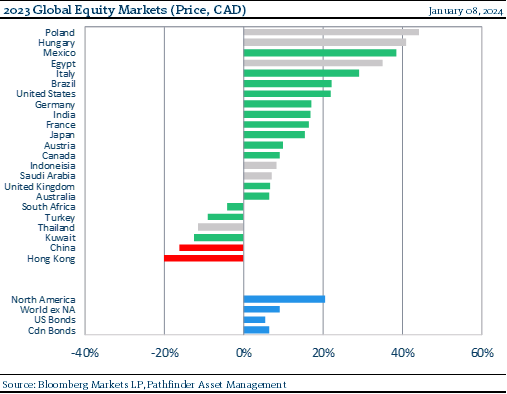
NORTH AMERICAN EQUITY & HIGH INCOME REVIEW
For the calendar year 2023, the North America Equity portfolio returned 28.7% and the High Income portfolio returned 6.7%. Since our inception in 2011, our segregated portfolios have returned 7.7% and 6.6% respectively annualized to December 31, 2023 (please see Figure 2).
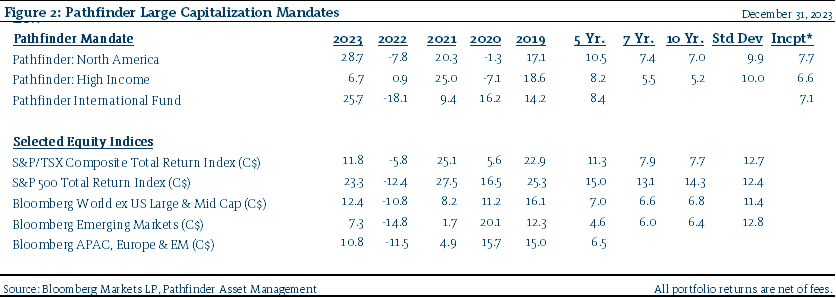
We have accomplished this while taking less risk vs. equity markets – between three quarters and two thirds of broad market indices, as measured by annualized standard deviation (the monthly fluctuations of your portfolio market value). We have been able to minimize our portfolio standard deviation with two main strategies. First, we invest in companies that are stable cash flow producers and are priced at a discount to their fundamental value. This should inherently lead to less volatile portfolios. Second, when the price of a share of a company that we own rises above what we think it is worth in the best-case scenario, we sell or reduce our position and allocate that cash to another company that has better value. If we cannot find another company, then we hold the cash in a treasury bill. Holding the cash serves two functions: One, it reduces the risk of the portfolio when we believe prices are too high and two, it provides us an option to buy more shares of good quality companies when prices are lower. Returns were quite dramatic this year and look very different from 2022. In our North American Equity portfolio, Nvidia Corp (NVDA US) +230.8%, Intel Corp (INTC US) +85.6%, Stella-Jones Inc (SJ CN) +58.9%, Alphabet Inc (GOOG US) +55%, and Microsoft Corp (MSFT US) +53.1% were our best performers (all in CAD). This was the exact opposite of last year, which demonstrates how volatile markets have been. Conversely, it was the bank and telcos that were a drag for 2023. Toronto Dominion Bank (TD CN) -2.3%, Bank Of Nova Scotia (BNS CN) -2.8%, Verizon Communications (VZ US) -6.6%, Nike Inc (NKE US) -9.4% and AT&T Inc (T US) -11% were the worst performers (returns do not include dividends).
There is a difference between trading the market and investing in companies. At Pathfinder, we invest in companies. We aim to buy good quality companies with stable cash flows at a low price. This year, we did much less trading than last year, and we remain generally satisfied with our investment management execution. Sometimes doing nothing is the best investment decision and this year, our less active approach to portfolio management was definitely a plus, as we let our “winners run”.
The High Income portfolio also had satisfactory results considering the mandate and the change in both market leaders and interest rates We construct the portfolio primarily from the current holdings of the North American Equity mandate and supplement from Core 100 stocks that offer attractive and sustainable dividends. There are three important metrics that we focus on with respect to dividends:
1. The current yield of the stock or trust is important. There must be enough yield, paid as dividends or a distribution, to act as a bond-like substitute for investors requiring cash flow for lifestyle purposes.
2. The second, and equally important metric, is the sustainability of the dividend. There has to be enough sustainable, repeatable cash flow generated by the company to ensure that, even during periods of stress, the probability of a dividend cut is low. There is also an element of management evaluation. For dividend sustainability to work, there must be a consistent management policy that pays a certain percentage of free cash flow out to the shareholder. If this policy is consistent, and we evaluate the company’s capability to protect free cash flow properly, then the dividend should hold over time.
3. Third is the ability of the company to grow its cash flow, and therefore its dividend in tandem over time. If the company can do this, then given that the book value of the investor’s original position in the portfolio does not change, the yield-to-book should grow. In this case, we are less concerned about the current valuation of the stock, it can go up or down, but more concerned with the portfolio dividend flows based on invested capital. The result is an inflation-adjusted bond-like cash flow, but with equity portfolio volatility that the investor should ignore… so long as the dividends remains intact.
We present a comparison between the two mandates in Figure 3. At the end of the year, the High Income Portfolio had less cash (2.3% vs 12.3%), than the North American Equity portfolio, which is a significant change from last year. The High Income portfolio had essentially zero exposure to technology stocks and that was the main driver of the difference between the results of the two mandates. While the lack of technology stocks did not add value this year, it was a substantial risk savings last year, resulting in satisfactory multi-year performance. This is an important distinction between this portfolio and others. We strive to include companies with stable cash flow, therefore, there will be periods when the market effectively oscillates around those stable cash flows. The portfolio also has better valuation metrics (PE, PS), which in theory would have provided more downside protection during periods of market stress.
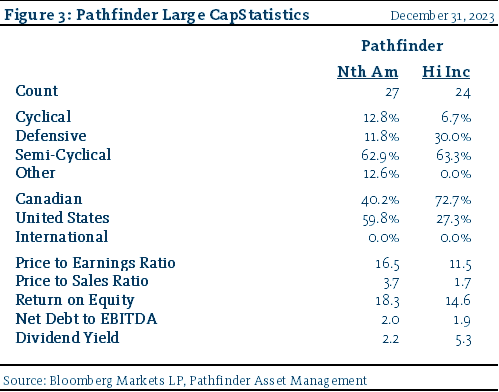
PATHFINDER INERNATIONAL FUND
For the year, the Pathfinder International Fund returned 25.7% while International Developed & Emerging Large/Mid Cap Markets were up 10.8% (both in CAD terms). International markets had a much better year, but there paradoxically remains substantial value in a number of the geographic regions and themes that we follow. For the year, World stocks returned +19.3% and European stocks +16.5%. Asian markets were up 7.5%. It was generally more difficult to find good performance in Asia and emerging markets, however, this is where we still see substantial value. A combination of poor economic conditions and geopolitical issues caused investors to again focus on US companies and in particular technology stocks. However, Japan was a standout (+18.3%) with excellent performance, including technology companies.
The main reason for the difference is the fund’s performance relative to “the market” was again its high exposure to China, which was a negative, and technology stocks, which was a huge positive (please see Figure 4). We have not materially changed our themes that we identified in 2019 and still focus on technology (hardware, ecommerce, and industrial electrification & automation), banking and retail in Asia, along with a few special situation commodity companies.
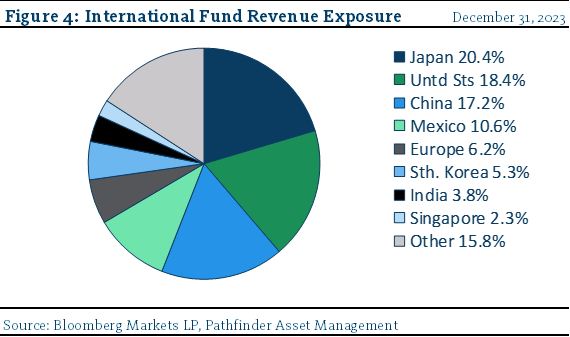
Our process is to identify the emerging themes and geographic areas that will benefit from medium to long-term structural trends. Then we add the companies that we believe are the best positioned globally to exploit those opportunities. For this reason, we expect the composition of the portfolio to change this year, along with the Core 100, which we would like to drive based on more thematic views, rather than sectors defined by the index publishers.
Our best performers for the year in CAD were Nvidia Corp (NVDA US) +230.8%, Intel Corp (INTC US) +85.6%, Tokyo Electron (8035 JP) +76.9%, Nec Corp (6701 JP) +63.6%, and Prologis Mexico (FIBRAPL 14 MF) +62.5%. This is a substantial change from last year, however, again the drawdown in Chinese stocks continued in dramatic fashion for most of the year. A sharp rally in December was followed by another drawdown in January as we write. China is one of the few areas where we see true value in stocks. It was also the worst performer for the year: Tencent (700 HK) -9.8%, Prudential Plc (PRU LN) -19%, Sunny Optical (2382 HK) -25.6%, Kingdee International Software (268 HK) -33.7% and Meituan (3690 HK) -54.3% (all returns above do not include dividends).
Much like the North American Equity portfolio, the International Fund now has excess cash. We were somewhat more aggressive about risk mitigation and selling stocks at what we perceived were high valuations. In the end, that was a mistake, and we should have just held the portfolio fully invested for the whole period (i.e. the sometimes “less is more” debate). We did initiate a short on Chinese stocks part way through the year, which turned out to be ultimately the correct decision but, as a result, we missed the rally in the last month of the year. We also should not have lightened our Nvidia, and Cameco positions, however, for the most part, we remain very comfortable with the companies that we own and the results over the past year.
CORE PORTFOLIO STATISTICS
We include Figure 5, which presents the difference between the Pathfinder Large Cap mandates and three broad indices produced by Bloomberg Markets LP. Pathfinder mandates do not look like any common benchmark portfolio. We are more concentrated, have better valuation metrics and stronger company fundamentals. Over the years, our allocation to sector, geography and cash have changed dramatically. We take a real investment stance, move capital opportunistically and, as a result, expect a more efficient return profile. We cannot guarantee better performance, but we can guarantee that we will be different. In our opinion, this is what most investors are missing in their own personal investment structure. When our Counselling Team discuss investment policy with clients and prospects, they discuss three basic options for the operation of an investment portfolio:
- “do it yourself”: There are many “do it yourselfers” and if one is interested, diligent and has the time to dedicate, this is a great way to manage a portfolio. It permits maximum flexibility and is clearly the cheapest. However, individual results can vary, and most people are often not objective about evaluating themselves. Furthermore, there are certain strategies that are difficult to do by oneself;
- and/or “index”: The second cheapest is passive investing, which is also a very valid approach. In this case, a very low-cost ETF and a long-term strategy (i.e. avoid selling in panic times) guarantees average returns with an essentially institutional type fee;
- and/or “hire a pro”: Many people also hire a professional investor. This unfortunately comes with mixed results. There are some great money managers who offer good performance and good service but there is an associated fee. In some cases, it works and in others it does not. Many professional investor services also rely on outsourced money management and, in turn, blend multiple portfolios together, essentially creating a passive portfolio with an active fee. This guarantees that the client earns subpar returns and ultimately leads to a poor client experience. When hiring a money manager, the “buyer beware” philosophy holds very true.
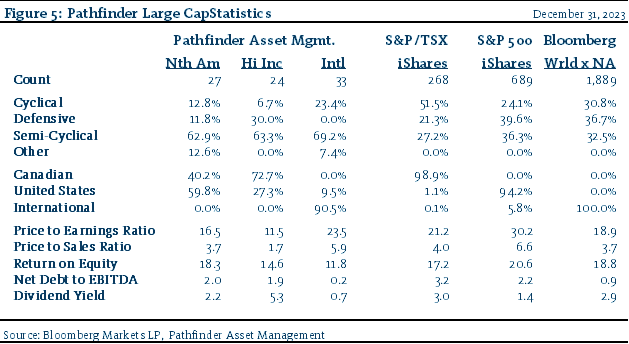
I added the “and/or” in front of each option because we find that some of the most interesting client portfolios mindfully blend multiple approaches. The trick is to be mindful with the selection of the strategies. At Pathfinder, our Counselling Team are actively involved in helping clients do this.
A NOTE ABOUT FIXED INCOME:
We have a number of clients where we blend in a laddered, investment-grade fixed income portfolio to their equity and fund positions for risk mitigation and capital preservation purposes. We have historically stated that given the interest rate environment, we did not view fixed income as a source of investment return but rather a store of nominal value (i.e., loss of capital is limited, other than erosion from inflation). This has clearly changed.
During the early part of my career, a typical client’s Investment Policy Statement could be wrapped around a balanced portfolio (60% equity, 40% fixed income). The bond portion of the portfolio was usually targeted to provide cash flow for a fixed liability (living expenses, for example) and the equity portion of the portfolio was used for growth to build the portfolio in order to protect its purchasing power over time. That changed in the mid 90’s as long bond rates dropped below 6%. While there was an initial, (significant) capital gain, once the tenor rolled off and the bond matured, it was very difficult to reinvest for any duration that paid what investors thought was a reasonable rate, given that interest rates would eventually increase again. The longer the low rate environment persisted, the riskier it was to add long bonds to a portfolio. This is because of the substantial capital loss that would occur on rate reversal. In early 2022, rates did in fact reverse, so now the landscape has changed again. We are now most likely at the beginning of a very long-term adjustment in the stability of bonds as a true portfolio investment option.
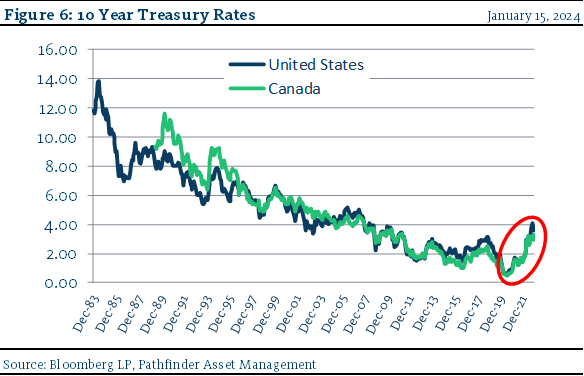
For our Fixed Income Portfolio, we have remained allocated to short duration bonds. This is a good way to preserve capital as they are less sensitive to interest rates. We also believed that credit spreads have been too small to warrant investment in most corporate bonds, thus we have tilted the portfolio more towards government bonds. We said that we would need to see mid-to-high single digit bond rates with moderate inflation before we would again consider fixed income a contributing part of our investment process, and this appears to be happening.
For clients that require fixed income for living expenses, we have historically substituted our High Income portfolio for the equity portion of the investment policy statement and used our short bond ladder for the fixed income portion. This has resulted in exceptional relative performance for these investors, particularly after the recent structural change in the various interest rate terms. With rates now increasing, we consider fixed income a viable investment alternative, given that it appears that core inflation has somewhat moderated. This year we added more fixed income into client accounts and expect that over time as opportunities present themselves, further allocation to the asset class in a more balanced approach makes sense. We will also be changing the composition and strategy of the bond portfolio. In the coming year we will add more detailed review and analysis to our reporting as the allocation is further built out.
CURRENT INVESTMENT OUTLOOK
Every year, we reread what we wrote the previous year in this section. We compare what we thought the coming year would bring against what actually happened. One of the nice things about writing on a regular basis is that we can track how our thought process evolves. This provides us with the opportunity for reflection, which is critical for investors. We did the same thing with last year’s Current Investment Outlook section before we began to write this year’s and we were reminded again about how quickly markets can change and how difficult it is to predict their direction over the short term. This ultimately reinforced our investment thesis: we do try to “time” but instead focus on buying great quality, growing companies, that we believe are mispriced by stock market participants.
In October of 2022, equity markets had reached the bottom of what was at the time, a very quick bear market (down -24.5%). From there, until the end of 2023, the S&P500 rallied 36.1% (Figure 7) to all time highs. It might be difficult to remember, but at the end of 2022 most market pundits were predicting the opposite. Bloomberg published a survey showing 70% of economists predicted a recession in the coming year (i.e. in 2023). Pessimism was high. This obviously did not happen, and strategists and economics were quick to revise their numbers to catch up. One thing that I find strange in financial markets is the “next year market prediction” that so many investment banks produce just because the end of the year has arrived. To be clear: there is literally no connection between the economic or market cycles and New Year’s Day. This past year is a perfect example of why those predictions should be completely ignored by investors. Essentially no one predicted all-time the high in stock markets driven by 7 US technology stocks, but that is in fact exactly what happened.
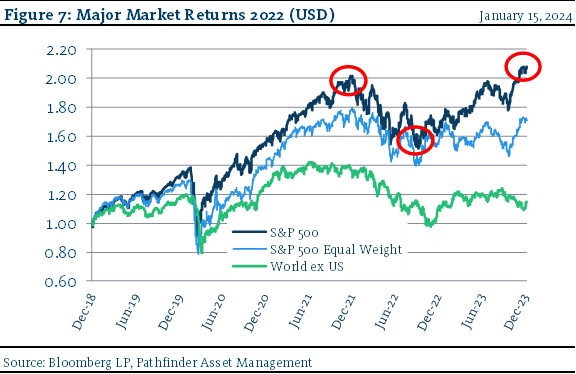
This year in Figure 7, we also included the S&P 500 Equal Weight index (light blue line). The S&P500 Equal Weight is comprised of the same stocks as the regular S&P500 index but weighted equally instead of by market capitalization. The equal weight index has historically performed better than the cap weighted index: 10.6% per year for 20 years to the end of 2022 vs. 9.8% for the cap weighted. This is because small capitalization companies are represented in the same proportion as large capitalization companies in the equal weight index and those companies typically have more growth, given they are starting from a smaller base. However, this year the opposite was true. The cap weighted index was up 26.3% and the equal weight up only 13.8%. This is because the well popularized Magnificent 7 (NVIDIA, Meta, Amazon, Microsoft, Alphabet, Apple and Tesla) return 76.1% as a group!! This is an important difference that we believe most investors should pay attention to. Market cap indices are used to create ETFs and consequently have become the primary benchmark for all portfolios. A large ETF provider or money manager with hundreds of billions of dollars to invest must use market weighted indices because it is impossible to buy an equal weight portfolio with that much capital. However, most investors do not have billions of dollars to deploy, so an equal weight portfolio is a real option to consider. It provides small investors with a structural advantage that can be exploited. This is in fact how we manage at Pathfinder.
We revisit the discussion from last year with respect to inflation as it remains material again this year. The big question on everyone’s mind remains what will happen with inflation. While moderating somewhat this year, inflation has not been this high since the early 1980’s and its forward path has significant implications for investors. Figure 8 presents Personal Consumption Expenditures (PCE), which is the US Federal Open Market Committee’s preferred inflation measure. When the PCE falls to around 2%, we will be back in a “normal inflationary environment” (the dark blue line has been around 2% since the early 1990s). We have also included traditional CPI, which is often quoted in the financial press. It appears that both peaked in the early spring of 2022. Will inflation rise back above the recent highs? That is a critical question. So far, we have seen some disinflationary pressure: supply chains are normalized, and cost of goods have somewhat moderated but wages and services remain a concern for potential inflation. The low unemployment rate and the potential impact of a re-emerging China on demand, including commodities, could also drive inflation higher. Figure 9 presents Goods and Services inflation (both appear to have peaked) along with the unemployment rate, which remains at all-time lows.
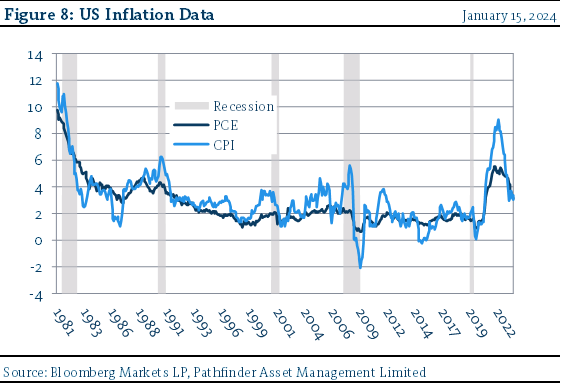
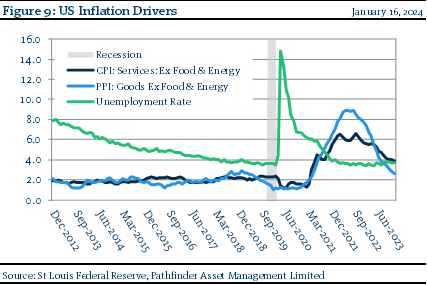
We present in Figure 10, headline inflation data from other parts of the world. What strikes us is how different each of the major areas are in terms of level but also that they all appear to have peaked. Note that at Japan’s current inflation rate of 2.8%, it is well above its average given that for decades deflation has been the issue in Japan. China is now essentially on its own with low inflation. As China attempts to manage stimulating its economy, one can only expect that this number will rise and have an impact on the rest of the world, if they are in fact successful in those efforts.
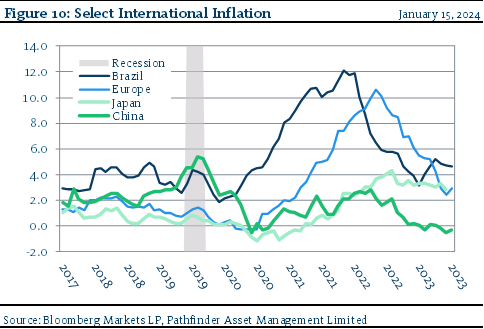
We published The Buffett Valuation (broad US stock market capitalization divided by US GDP) from since 1970 in Figure 11. It was at an all-time high in 2021, fell back and then grew again last year. We are now well past the peak of the dot-com bubble from the late 1990’s. This does give us some concern with respect to valuation, especially with technology stocks. We will look aggressively in other areas for good investment opportunities.
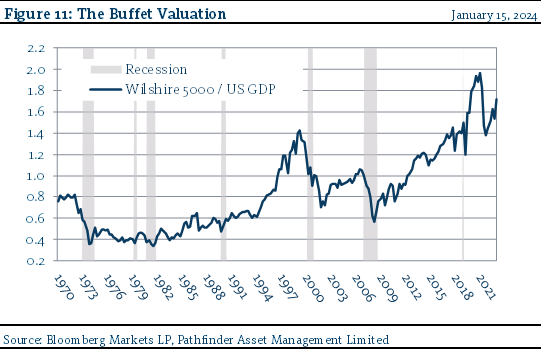
We are paying special attention to what appears to be a growing difference between the economic paths of large blocks of the global economy. The US, China, Japan, and Europe seem to be evolving in distinctly different trajectories. This is different than in the recent past, where globalization resulted in a more correlated environment. The US and China have internalized their focus, both with respect to geopolitical policy and economic independence. There is clear evidence that the decades long US hegemony has evolved. The US government appears focused on repatriating domestic production of critical parts of its supply chain and moderating its geopolitical activities. It remains clear to us that the focus is more nationalistic rather than previously championed globalism. This notably appears true across both Republican and Democratic administrations. China, much like the US, is also actively pursuing domestic economic policy. Japan is emerging from a multi-decade deflationary environment and is still actively struggling with a demographic problem (as China will soon be). Europe, in our view, still has economic structural difficulty, and corporate management outlooks continue to be quite depressed.
These 4 groups represent 64% of the global economy according to the International Money Fund. Figure 12 presents price earnings multiples for the 4 regions. The difference is quite material and does not happen very often. We can clearly see true differentiation by geographic region both with respect to economies and valuations. While there are opportunities to identity companies exposed to regions that we believe will perform better, the differentiation will also allow us to benefit from true investment diversification across the different regions that we currently invest in.
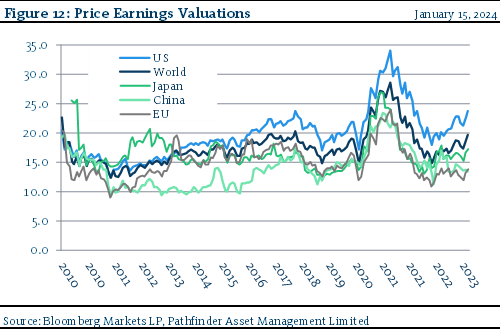
Conclusion: We will continue to look for good quality, mispriced investments. The fortunate combination of good valuations and differentiated economic trajectories provides us the opportunity to position the portfolio for what we believe will be the next cyclical expansion. Over the long term, our investment view remains constructive and unchanged.
CORE:100
We maintain a list of what we consider to be world class companies in all industries and across all major geographic areas. We regularly screen global stocks, based on our valuation framework, for new names that we consider for addition to our universe of coverage. We focus on well managed, fundamentally strong firms that consistently generate and grow cash flow. We expect strong quality management teams to reinvest that cash flow in improving their businesses. These firms have defensible advantages and ideally return any excess capital to their owners (i.e. us!!) in a rational, economic and consistent manner. The list is then filtered for qualitative factors including sector balance, general economic trends and changes in technology. We then generate buy and sell targets for each company in the universe. This is what drives our portfolio investment decisions. Our thesis is that these companies should do better than the general market over the long-term and, more importantly, they should outperform during the regular periods of distress that we seem to have every 7-10 years. If we are buying from a list of “the best companies in the world” and buying consistently at a discount, then the portfolios that we construct should do better on a risk-adjusted basis as well.
We have expanded past our 100 names in the Core 100 as we find new additions and our investment thesis evolves to include more international companies. Generally, this is a slow-moving process that does not change significantly from year-to-year, but some evolution is healthy given global changes and the ongoing development of our investment views. In 2023, we had limited movement of companies. Given the recent turmoil in economies from the various reactions to the pandemic and major geopolitical challenges, we have reserved adjustment for the past couple of years but expect significant turnover for the next few. We also expect to rotate to a more thematic based composition over time, rather than based on traditional industry structure. Figure 11 presents our current characteristics against large exchange-traded fund portfolios and indices. As you can see, our metrics tend to be more value focused with less leverage than the board markets.
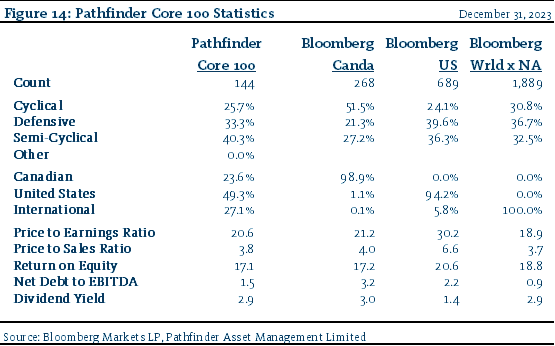
We are always looking to improve the quality of the companies that we consider for the portfolios. We run screens that identify new companies that fit the broad parameters of what we consider to be a “good” company. The list is continually expanding and over the coming year it will be reviewed to determine if there is a potential fit for the Core 100.
National Instrument 31-103 requires registered firms to disclose information that a reasonable investor would expect to know, including any material conflicts with the firm or its representatives. Doug Johnson and/or Pathfinder Asset Management Limited are an insider of companies periodically mentioned in this report. Please visit www.paml.ca for full disclosures.
Changes in Leverage. We are increasing the liabilities ceiling to 2.0 times the market value of equity for Pathfinder International Fund and Pathfinder Real Fund to be consistent with Pathfinder Partners’ Fund and Pathfinder Resource Fund.
*All returns are time weighted and net of investment management fees. Returns from the Pathfinder Partners’ Fund and Partners’ Real Return Plus Fund are presented based on the masters series of each fund. The Pathfinder Core: Equity Portfolio and The Pathfinder Core: High Income Portfolio are live accounts. These are actual accounts owned by the Pathfinder Chairman (Equity) and client (High Income) which contain no legacy positions, cash flows or other Pathfinder investment mandates or products. Monthly inception dates for each fund and portfolio are as follows: Pathfinder Core: Equity Portfolio (January 2011), Pathfinder Core: High Income Portfolio (October 2012) Partners’ Fund (April 2011), Partners’ Real Return Plus Fund (April, 2013), and Partners’ Core Plus Fund (November 2014).
Pathfinder Asset Management Limited (PAML) and its affiliates may collectively beneficially own in excess of 10% of one or more classes of the issued and outstanding equity securities mentioned in this newsletter. This publication is intended only to convey information. It is not to be construed as an investment guide or as an offer or solicitation of an offer to buy or sell any of the securities mentioned in it. The author has taken all usual and reasonable precautions to determine that the information contained in this publication has been obtained from sources believed to be reliable and that the procedures used to summarize and analyze such information are based on approved practices and principles in the investment industry. However, the market forces underlying investment value are subject to sudden and dramatic changes and data availability varies from one moment to the next. Consequently, neither the author nor PAML can make any warranty as to the accuracy or completeness of information, analysis or views contained in this publication or their usefulness or suitability in any particular circumstance. You should not undertake any investment or portfolio assessment or other transaction on the basis of this publication, but should first consult your portfolio manager, who can assess all relevant particulars of any proposed investment or transaction. PAML and the author accept no liability of any kind whatsoever or any damages or losses incurred by you as a result of reliance upon or use of this publication.